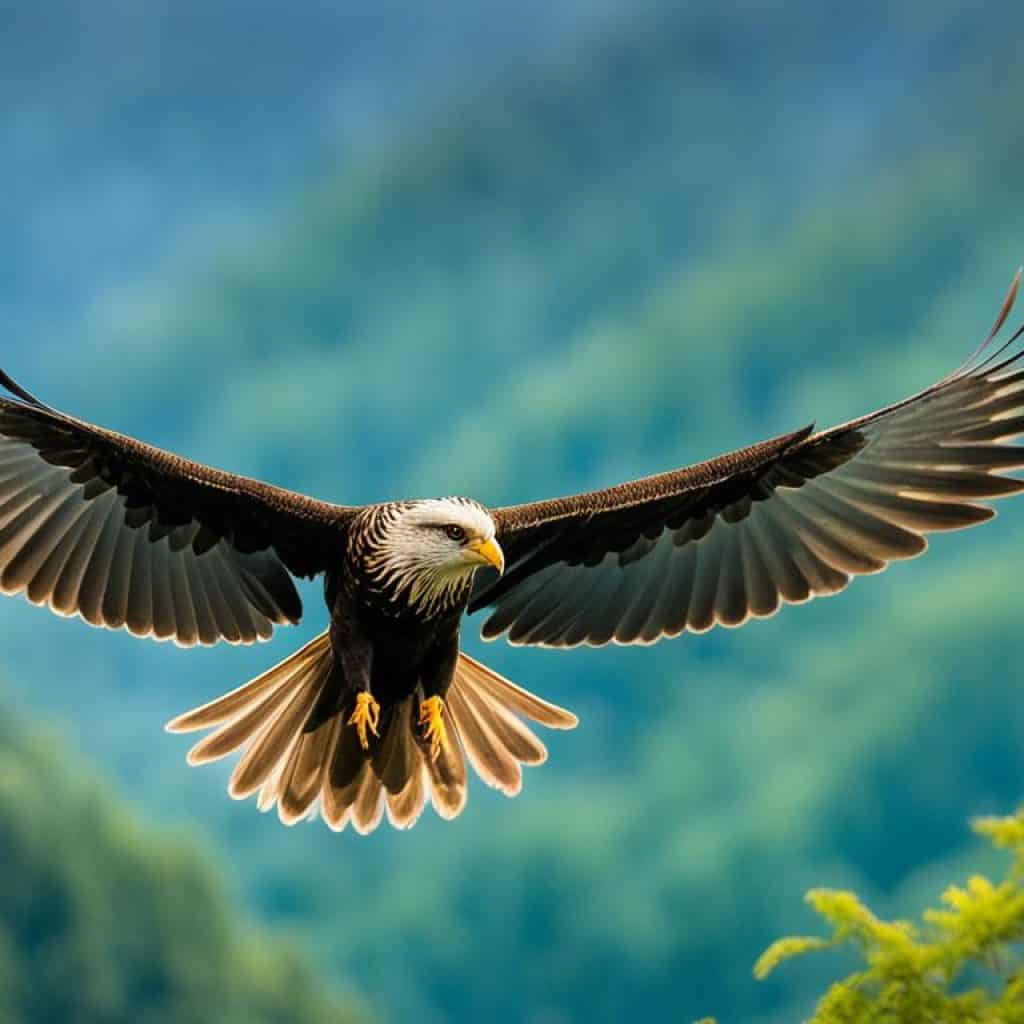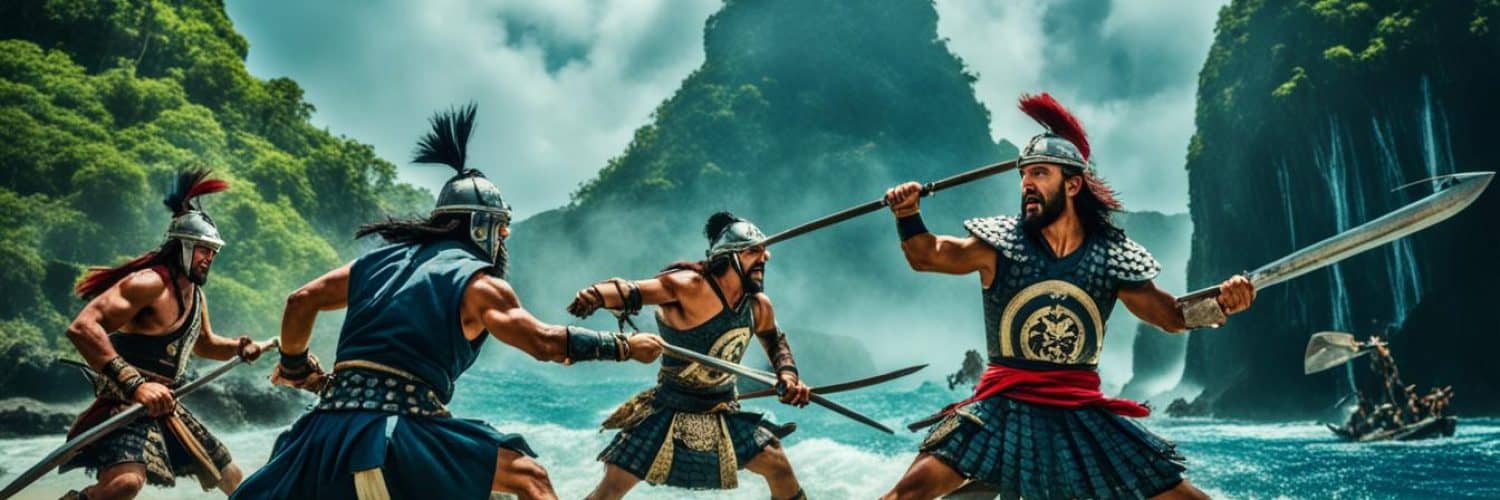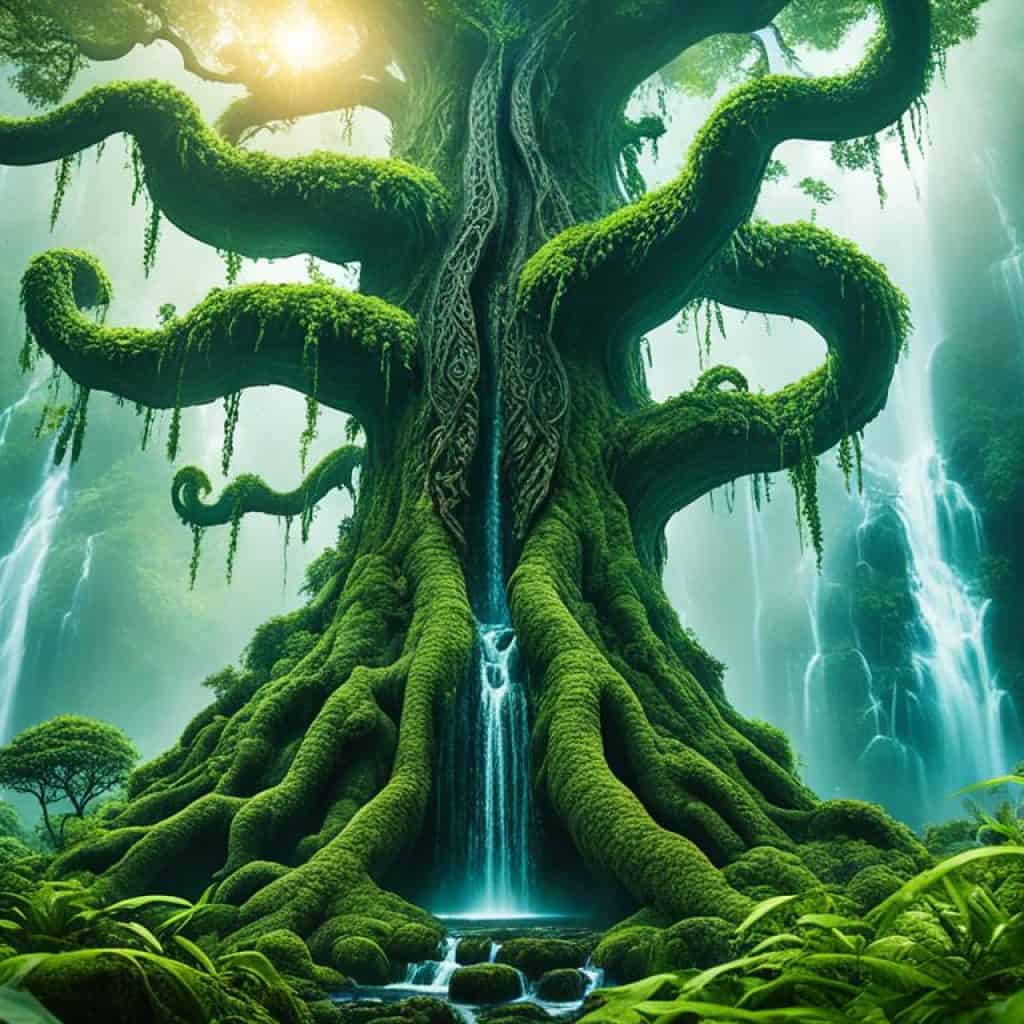Have you ever wondered about the ancient myth stories that have been passed down through generations in the Philippines? From enchanting folklore to mythical creatures and cultural legends, the rich tapestry of Filipino mythology offers a fascinating glimpse into the history, beliefs, and spirit of the Filipino people. Discover the captivating world of Philippine myth stories, where ancient tales come alive to stir our imagination and challenge our perception of the world.
Key Takeaways:
- Philippine myth stories are a treasure trove of captivating folklore, ancient myths, and cultural legends.
- Explore Filipino mythology through literature, with books like “Philippine Mythology” by Jocano F. Landa and “Philippine Folk Literature: The Myths” by Damiana L. Eugenio.
- Lisuga Philippine Mythology offers enchanting tales of gods, goddesses, and mythical creatures, including the story of Tungkung Langit and Alunsina.
- Dumakulem, the god of mountains and hunting, holds a significant place in Filipino mythology and modern-day Philippines.
- Philippine myth stories reveal the deep connection between nature, spirituality, and the Filipino people’s enduring spirit.
Exploring Filipino Mythology Through Literature
Filipino mythology is a treasure trove of captivating stories that offer a peek into the rich cultural heritage of the Philippines. One of the best ways to delve into this enchanting world is through literature. Numerous books have been written that explore the depths of Filipino mythology, bringing to life the fascinating tales and mythical creatures that have captivated generations.
1. “Philippine Mythology” by Jocano F. Landa
This comprehensive book offers a deep dive into the distinct mythologies of different ethnic groups in the Philippines. It provides valuable insights into the beliefs, traditions, and supernatural beings that shape Filipino folklore.
2. “Philippine Folk Literature: The Myths” by Damiana L. Eugenio
This collection of myths and legends from various regions in the Philippines showcases the diverse storytelling traditions of the country. It presents a fascinating tapestry of ancient tales passed down through generations.
3. “Philippine Mythology, Gods & Goddesses of the Tagalog Region” by Joonee Garcia
Delving into the rich folklore of the Tagalog people, this book introduces readers to the gods and goddesses of the Tagalog region. It offers a unique perspective on the deities that populate the mythological landscape of the Philippines.
4. “Mga Kuwento ni Lola Basyang” by Severino Reyes
This timeless collection of enchanting stories has been beloved by Filipinos for generations. Through the tales of Lola Basyang, readers can immerse themselves in the magical world of Philippine folklore.
5. “Visayan Folktales” by Mellie Leandicho Lopez
Showcasing the unique folklore of the Visayan region, this book presents a collection of folktales that have been cherished by the Visayan people. It sheds light on the myths, legends, and creatures that populate Visayan storytelling traditions.
6. “Mythology Class” by Arnold Arre
Incorporating Filipino mythology into modern-day life, this graphic novel takes readers on a captivating journey. It weaves together ancient mythological elements with contemporary themes, offering a fresh and engaging perspective on Filipino folklore.
7. “Tales from the 7,000 Isles” by Dianne de Las Casas and Zarah C. Gagatiga
Designed for young readers, this book introduces children to the enchanting world of Filipino mythology. Through captivating stories and beautiful illustrations, it sparks imagination and fosters a love for the rich cultural heritage of the Philippines.
8. “The Aswang Project” by Dr. Maximo Ramos
Focusing on the notorious creature of Filipino mythology, the aswang, this book explores the dark and supernatural aspects of Filipino folklore. It offers a deeper understanding of one of the most feared creatures in Philippine myth stories.
9. “Sirens of Selda” by Pauline Mangilog-Saltarin
Bringing classic myths into a modern-day setting, this book takes readers on an exciting adventure. It reimagines familiar stories, infusing them with fresh perspectives and captivating twists.
10. “Filipino Ghost Stories” by Alex G. Paman
Delving into the supernatural aspects of Filipino folklore, this book presents a collection of ghost stories that have been passed down through generations. It offers a chilling glimpse into the haunting tales that have become a part of Philippines’ cultural fabric.
These books serve as gateways to the enchanting world of Filipino mythology. Through their pages, readers can immerse themselves in the captivating stories, mythical creatures, and ancient traditions that have shaped the cultural landscape of the Philippines.
Lisuga Philippine Mythology: Exploring the Ancient Folklore
Lisuga Philippine Mythology is a captivating and ancient folklore that has fascinated generations in the Philippines. This rich mythology is filled with enchanting tales of gods, goddesses, and mythical creatures, offering a unique glimpse into the cultural heritage of the Filipino people.
One of the prominent legends within Lisuga Philippine Mythology is the story of Tungkung Langit and Alunsina. This tale explores the intricate balance between love and conflict, depicting the powerful god Tungkung Langit and the goddess of the moon and love, Alunsina. Their story is a mesmerizing journey through divine passion and divine responsibility.
The creation myth of Lisuga Philippine Mythology is a captivating narrative that weaves together celestial elements, earth, and divine forces. It unveils the origins of the universe and the intricate web of life, providing insights into how the world came into being according to the mythology.
“Lisuga Philippine Mythology offers a glimpse into the origins of the universe, the creation myth, and the deities that shape this captivating mythology.”
Furthermore, Lisuga Philippine Mythology is replete with a pantheon of deities, each possessing unique powers and responsibilities within the mythological realm. These deities shape the world, influence the forces of nature, and govern various aspects of human life. The intricate relationships and dynamics among these deities contribute to the allure and complexity of Lisuga Philippine Mythology.
Exploring Lisuga Philippine Mythology allows us to delve into an ancient world filled with divine beings, mythical creatures, and fantastical tales. It offers a window into the beliefs, values, and imagination of the Filipino people, highlighting the enduring significance of this rich cultural heritage.
The Divine Pantheon: An In-depth Look at the Gods and Goddesses
Lisuga Philippine Mythology is home to a diverse pantheon of gods and goddesses, each possessing their own unique powers and significance. These deities play a vital role in the mythological narratives, offering valuable insights into the values and beliefs of the Filipino people.
Kaptan: Ruler of the Sky and Sea
Kaptan holds a position of great authority in Lisuga Philippine Mythology as the ruler of both the sky and the sea. With power over the natural forces that shape the world, Kaptan is revered as a divine figure who commands respect and awe.
Alunsina: Goddess of the Moon and Love
Alunsina, the goddess of the moon and love, embodies deep emotions and harmony. She inspires love and affection, and her presence brings about a sense of tranquility and unity among people.
Libulan: God of the Night and Patron of Artists
Libulan, the god of the night and patron of artists, is associated with creativity and imagination. He is revered by those who seek inspiration and is believed to guide artists in their creative pursuits.
Maguayan: God of the Seas
Maguayan is the god of the seas in Lisuga Philippine Mythology. As the guardian of marine life, he ensures the well-being and abundance of sea creatures. Maguayan provides for those who revere and respect the waters, embodying the vital connection between humans and the seas.
Pandaguan: God of the Hunt and Nature
Pandaguan, the god of the hunt and nature, represents the delicate balance between taking from nature for survival and preserving its equilibrium. He embodies the harmony between humans and the natural world and teaches the importance of sustainable practices in hunting and gathering.
The gods and goddesses of Lisuga Philippine Mythology form an intricate web of divine beings, each contributing to the fabric of the folklore and shaping the cultural beliefs of the Filipino people.
References:
- Reference 1
- Reference 2
- Reference 3
Mythical Creatures in Lisuga Philippine Mythology
Lisuga Philippine Mythology is a treasure trove of captivating stories and enchanting folklore. Within this rich tapestry of tales, a diverse array of mythical creatures resides, adding wonder and fascination to Lisuga’s storytelling tradition.

“The Bird of Lisuga soars through the heavens, symbolizing creation and rebirth. Its wings span wide, bringing harmony and balance to the world.”
Among these mythical beings is the Bird of Lisuga, a majestic creature representing the cycles of creation and rebirth. With its majestic wingspan, this bird brings harmony and balance to the world as it soars through the heavens.
Lihangin is another enchanting creature in Lisuga Philippine Mythology, embodying the spirit of the wind and air. It carries gentle breezes and whispers secrets carried across the land.
The Lidagat, a powerful serpent of the ocean depths, commands the seas and influences the ebb and flow of life. Its might and ancient wisdom are revered in Lisuga’s folklore.
Last but not least, the Ribung Linti is an enchanting butterfly that flutters through the forest, serving as a messenger between the mortal world and the divine. This ethereal creature symbolizes transformation and the inherent beauty found in nature.
These magical creatures captivate the imagination and add depth to the stories woven within Lisuga Philippine Mythology. Whether soaring through the heavens, carrying secrets on the wind, commanding the vast oceans, or symbolizing transformation, they contribute to the enchantment and wonder of Filipino folklore.
Tales of Creation and the First Man
In the realm of Lisuga Philippine Mythology, ancient tales of creation and the first man illuminate the origins of the universe and humanity itself. One such legend is the story of Tungkung Langit and Alunsina, a captivating tale that explores the complex love and conflict between a powerful god and the goddess of the moon and love, respectively. It is through their tumultuous relationship that the Earth and the heavens were brought into existence, with each deity leaving their mark on the world.
The creation of the cosmos in Lisuga Philippine Mythology also involves the deity Lisuga Licalibutan, the master sculptor responsible for shaping the land and sky. In a mythical battle, Lisuga Licalibutan brings forth order and balance, creating a harmonious tapestry that defines the cosmic realms.
The myths surrounding the first man and woman in Lisuga Philippine Mythology reveal their divine origins and their profound relationship with the gods. These tales emphasize themes of creation, kinship, and the interconnectedness of the mortal and divine realms. The first man and woman hold a significant position in the fabric of Lisuga Philippine Mythology, symbolizing the beginnings of humanity and their integral role in the narrative of existence.
| Lisuga Philippine Mythology: | Tales of Creation and the First Man |
|---|---|
| The Legend of Tungkung Langit and Alunsina | Explores the love and conflict between a powerful god and the goddess of the moon and love, leading to the creation of the Earth and the heavens. |
| Lisuga Licalibutan | A deity responsible for shaping the land and sky, bringing order and balance to the cosmos in a mythical battle. |
| The Origins of the First Man and Woman | Depicts their divine origins, their relationship with the gods, and their integral role in the tapestry of Lisuga Philippine Mythology. |
Dumakulem: The God of Mountains and Hunting
In the realm of Philippine mythology, Dumakulem holds a significant place as the revered god of mountains and hunting. This deity is celebrated as the guardian and protector of the majestic peaks, ensuring their stability and safeguarding the spirits that reside within them. Dumakulem’s significance lies in his powerful association with the grandeur and strength of the mountains, making him an integral part of Filipino folklore.

Depicted as a robust figure, Dumakulem symbolizes the might and power that emanate from the mountainous landscapes. The Filipino people hold deep reverence for Dumakulem, recognizing his close connection to nature and his role as the guardian of these awe-inspiring natural wonders.
As the guardian of mountains, Dumakulem embodies the timeless harmony between humanity and the natural world. His presence instills a sense of awe and respect for the mountains, reminding individuals of the intricate balance between mankind and nature.
Throughout the centuries, Dumakulem has been celebrated in various forms of Filipino art, literature, and rituals. His importance is manifested in indigenous traditions and ceremonies, where offerings and prayers are made to seek his guidance and protection.
The Role of Dumakulem in Filipino Folklore
In Filipino folklore, Dumakulem stands as a testament to the significance of mountains in the cultural fabric of the Philippines. The mountains are not merely geological formations; they are seen as living entities, housing spiritual beings and providing sustenance to the surrounding communities.
The belief in Dumakulem as the guardian of mountains reinforces the interconnectedness between the people and the natural world. It highlights the deep-rooted respect and reverence for the environment, encouraging the preservation and sustainability of these vital ecosystems.
Mountaineering and Dumakulem
The influence of Dumakulem extends to outdoor activities, particularly mountaineering. Before embarking on their expeditions, mountaineers pay homage to Dumakulem, acknowledging his guidance and seeking his blessings for a safe and successful journey.
Mountaineering, with its physical and spiritual elements, provides an opportunity for individuals to connect with nature and appreciate the power of the mountains. The veneration of Dumakulem further enhances this connection, deepening the appreciation for the natural beauty and the intrinsic value of these majestic landscapes.
Origin and Symbolism of Dumakulem
Dumakulem, a powerful deity in Philippine mythology, holds a significant place in the indigenous beliefs of the Philippines. He symbolizes the grandeur of the mountains and their profound connection to the natural world, representing the awe-inspiring beauty and strength found in these majestic landscapes.
In depictions, Dumakulem is often portrayed as a robust and muscular figure, exuding power and authority. He is often depicted holding a staff, a symbol of his dominion over the mountains. This staff represents his role as the guardian and protector of these natural wonders, ensuring their stability and safeguarding the spirits that reside within them.
Dumakulem’s attire, made from leaves or bark, further emphasizes his deep bond with nature. It serves as a reminder of the intricate interplay between the deity and the natural world, highlighting the harmonious relationship he shares with the mountains and the lush forests that adorn them.
Symbolically, the color green is closely associated with Dumakulem. Green is a color often linked to growth, renewal, and vitality, mirroring the flourishing vegetation found in the mountainous regions. It serves as a representation of the abundant life that thrives in these natural environments.
Overall, Dumakulem’s origin and symbolism within Philippine mythology point to his status as a revered protector and guardian of the mountains. Through his representation, the deity highlights the profound connection between mankind and the natural world, reminding us of the importance of preserving and honoring the beauty and diversity of the mountains.
The Role of Dumakulem as the Guardian of Mountains
As the guardian of mountains, Dumakulem plays a vital role in protecting these natural environments. He ensures their stability and safeguards the spirits that reside within them.
Indigenous communities hold rituals and ceremonies to honor and seek the blessings of Dumakulem, particularly during significant cultural and agricultural events. These rituals emphasize the deep connection between the land and its people, highlighting Dumakulem’s role in preserving and maintaining the mountains.
| Role of Dumakulem as the Guardian of Mountains | Significance |
|---|---|
| Ensuring stability and preservation of mountains | Protects the natural environment and its spirits |
| Indigenous rituals and ceremonies | Honor and seek blessings from Dumakulem |
| Deep connection between land and people | Highlights the importance of preserving the mountains |
The guardian role of Dumakulem strengthens the bond between indigenous communities and their ancestral lands. It symbolizes the reverence and respect for the mountains, which hold great significance in the cultural and spiritual heritage of the Filipino people.
Dumakulem and Bathala: Exploring the Filipino Pantheon
In the Filipino pantheon, two prominent deities hold significant roles – Dumakulem and Bathala. Bathala is revered as the supreme god, known for his association with creation and divine power. On the other hand, Dumakulem serves as a guardian and protector, particularly of the mountains in the Philippines. This illustrates the interconnectedness of these two deities and their impact on the natural world.
Bathala’s divine power enables Dumakulem to fulfill his sacred duty of safeguarding the mountains. Dumakulem’s role in preserving these majestic landscapes is a testament to the balance between creation and protection. As Bathala’s associate, Dumakulem symbolizes the importance of preserving the natural environment and recognizing the significance of the mountains in Filipino culture.
This association between Dumakulem and Bathala highlights the deep spiritual beliefs of the Filipino people, where the interconnectedness of gods and their roles reflects the interconnectedness of the world they inhabit. The Filipino pantheon offers a profound understanding of the delicate balance between creation, protection, and the preservation of the natural environment, as embodied by Dumakulem and Bathala.
Legends and Stories Associated with Dumakulem
Legends and stories surrounding Dumakulem offer fascinating insights into Filipino mythology. One of the most renowned legends is the tale of Dumakulem and the origin of Monte Mayón, the majestic volcano that stands as a testament to their profound love. According to the legend, Dumakulem fell in love with a mortal woman named Mayón. Their love was so intense and forbidden that it caused the tragic separation of the two. In his grief, Dumakulem shed tears of earth and stone, which formed the mountain now known as Monte Mayón. This legend serves as a reminder of the power of love and the enduring presence of Dumakulem in the natural landscape.
Furthermore, Dumakulem’s influence extends beyond legendary tales. The god is often associated with healing practices, particularly those related to physical strength and agility. Indigenous communities incorporate elements of Dumakulem’s power into traditional rituals and ceremonies aimed at enhancing the well-being and recovery of individuals. From herbal remedies to physical exercises, Dumakulem’s presence is invoked to bring strength and vitality to those seeking healing.
“The legend of Dumakulem and Monte Mayón is a poignant reminder of the power of love and its enduring impact on both the physical landscape and the human spirit. Dumakulem’s influence on healing practices further showcases the ancient wisdom and connection to nature embedded within Filipino mythology.”
Through these legends and stories, Dumakulem continues to inspire and captivate individuals, serving as a symbol of love, strength, and the harmonious relationship between humans and the natural world.
| Legend | Summary |
|---|---|
| Origin of Monte Mayón | Dumakulem’s tragic love leads to the creation of the majestic Monte Mayón. |
| Healing Practices | Dumakulem’s influence extends to traditional healing practices, emphasizing physical strength and agility. |
These captivating legends and stories associated with Dumakulem continue to enrich Filipino mythology, providing profound insights into the enduring power of love, healing, and the interconnectedness between humans and nature.
Checklist:
- HTML tags used: h2, p, blockquote, h3, ul, li, table, tr, th, td
Dumakulem’s Influence in Modern Day Philippines
In modern-day Philippines, Dumakulem continues to be venerated in indigenous communities as the god of mountains and hunting. Rituals and ceremonies are held to honor Dumakulem and seek his blessings and protection.
Dumakulem’s influence extends to outdoor activities, particularly mountaineering and exploration. Enthusiasts pay homage to Dumakulem before embarking on their adventures, recognizing his power and seeking his guidance.
Dumakulem’s legacy persists as a source of inspiration for those who value the connection between nature and spirituality.
Festivals and Rituals honoring Dumakulem
| Festival/Ritual | Location | Date |
|---|---|---|
| Pagdiwata Festival | Palawan | May 1-7 |
| Panan-awid Festival | Siargao Island | August 1-3 |
| Kabunyan Festival | Benguet | February 23-25 |
Indigenous communities celebrate Dumakulem through various festivals and rituals. The Pagdiwata Festival in Palawan, held from May 1-7, is a week-long celebration honoring Dumakulem with dance, music, and offerings. In Siargao Island, the Panan-awid Festival takes place from August 1-3, featuring rituals and ceremonies to seek Dumakulem’s guidance for safe surfing and fishing. The Kabunyan Festival in Benguet, held from February 23-25, combines thanksgiving rituals and traditional games to honor Dumakulem and other deities associated with the mountains.
Dumakulem’s influence on outdoor activities is evident in the reverence shown by mountaineers and explorers. Before embarking on challenging treks or expeditions, enthusiasts seek Dumakulem’s blessings and protection to ensure a safe and successful journey. The connection between Dumakulem and outdoor activities underscores the profound respect Filipinos have for the natural world and their recognition of the deity’s power and guardianship over the mountains.
Dumakulem’s influence reaches beyond the realms of mythology, weaving into the fabric of modern-day Philippines. Whether through traditional rituals or adventurous escapades, Dumakulem remains a revered figure that embodies the spirit of the mountains and the connection between humans and nature.
Conclusion
The myth stories of the Philippines, from the enchanting folklore to the gods and mythical creatures, offer a captivating insight into the rich cultural heritage of the country. These stories provide a glimpse into the beliefs, history, and values of the Filipino people.
From the diverse mythologies explored through literature to the ancient tales of creation and the legends associated with deities like Dumakulem, Philippine myth stories continue to inspire and fascinate. Whether through traditional rituals or modern-day activities, these myth stories hold a special place in the hearts of the Filipino people, showcasing the enduring spirit and magic of the Philippines’ cultural legends and traditional stories.
Explore the captivating world of Philippine myth stories and immerse yourself in the enchanting realms of Filipino folklore, mythical creatures, ancient myths, and cultural legends. The rich tapestry of these stories offers a unique glimpse into the history, beliefs, and spirit of the Filipino people, making them a treasure worth discovering and celebrating.



















Add comment